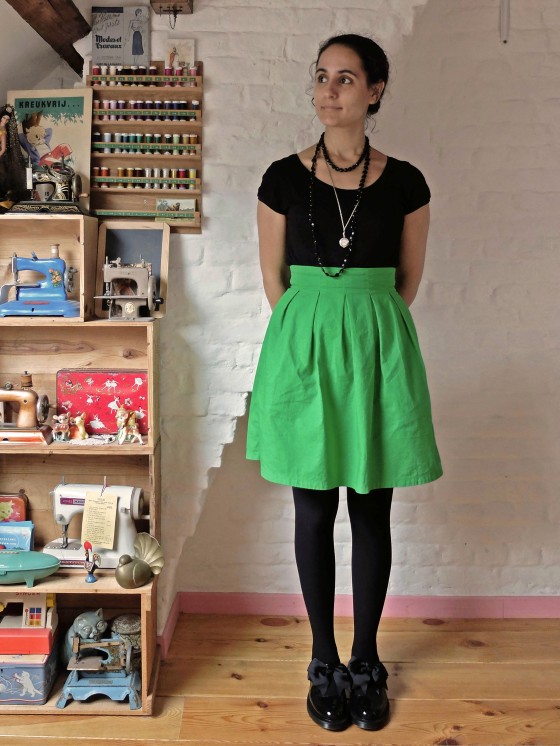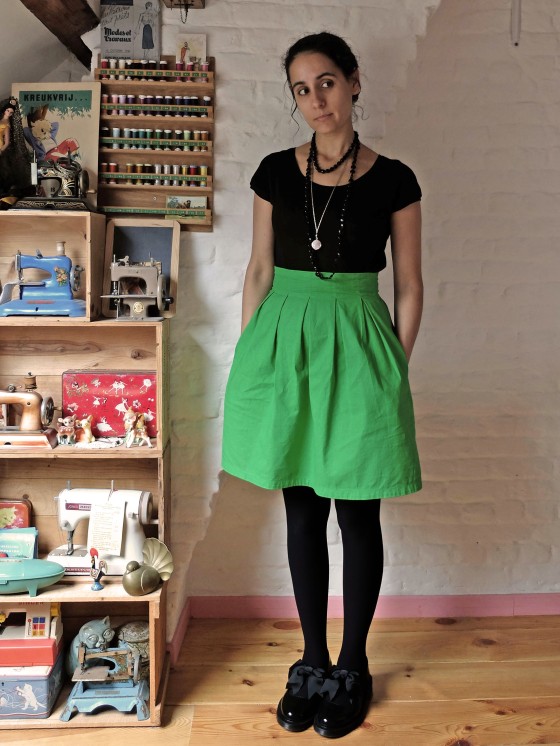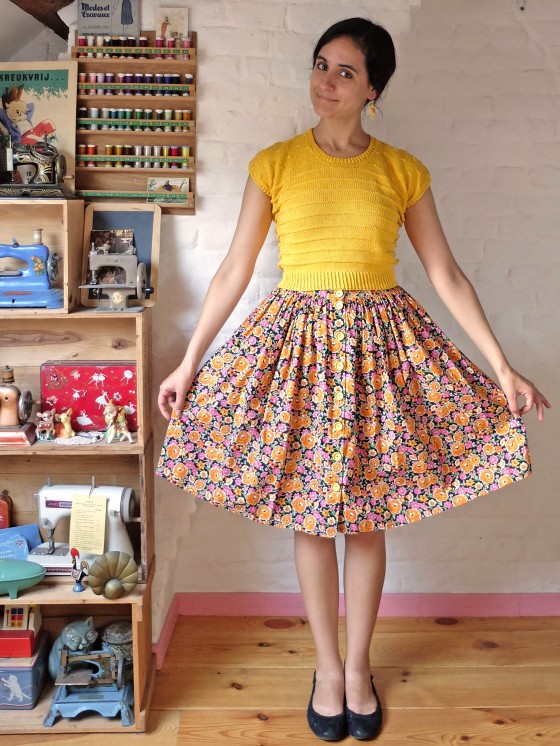 The vermilion Chardon skirt I made two years ago is one of those garments I reach for constantly, both in summer and winter. So when I found this vibrant green cotton at Les Tissus du Chien Vert earlier this year, I thought it would make a perfect new glaring Chardon that I knew would get a lot of wear.
The vermilion Chardon skirt I made two years ago is one of those garments I reach for constantly, both in summer and winter. So when I found this vibrant green cotton at Les Tissus du Chien Vert earlier this year, I thought it would make a perfect new glaring Chardon that I knew would get a lot of wear.
 I made this skirt in early May, so I can already tell you that it did indeed get a lot of wear, as did the t-shirt I’m wearing in the pictures, sewn a few days before. The t-shirt is also my second time using a pattern (and it’s also the same t-shirt I’m wearing in the pictures of the post about my first Chardon!), a two-piece tee (one front piece, one back piece) from this Ottobre magazine.
I made this skirt in early May, so I can already tell you that it did indeed get a lot of wear, as did the t-shirt I’m wearing in the pictures, sewn a few days before. The t-shirt is also my second time using a pattern (and it’s also the same t-shirt I’m wearing in the pictures of the post about my first Chardon!), a two-piece tee (one front piece, one back piece) from this Ottobre magazine.
 I finished the t-shirt differently from the first time, by substituting a narrow neckline/sleeve band to the neckline/sleeve binding. Other than that, it’s the same as the first one, but serged instead of sewn by machine (except for the top stitching, made with a double needle). It’s also exactly the same kind of slinky rayon knit as the purple one, but two years of experience made it way easier to cut than the first time around.
I finished the t-shirt differently from the first time, by substituting a narrow neckline/sleeve band to the neckline/sleeve binding. Other than that, it’s the same as the first one, but serged instead of sewn by machine (except for the top stitching, made with a double needle). It’s also exactly the same kind of slinky rayon knit as the purple one, but two years of experience made it way easier to cut than the first time around.
As for the skirt, I decided to bind all of the seams with bias tape, and I have to say I was pretty proud of the result! I was afraid it was going to be too bulky at the pockets, but it isn’t, so I’ll definitely use this method again in the future.
 I did screw up somewhere in sewing the pleats, though, which are a little wider (and less deep) than they should be. At first I made them the correct size, but when I tried on the skirt before attaching the zipper, I felt like it was going to be too snug. So I let out each pleat by a few millimetres to gain a couple centimetres. And of course, when I tried on the skirt a second time, this time with the zipper, it was way too big at the waist! I unpicked the zipper, and since I couldn’t be bothered to unpick and redo the pleats for the second time, I simply cut off the excess at the centre back seam and re-inserted the zipper.
I did screw up somewhere in sewing the pleats, though, which are a little wider (and less deep) than they should be. At first I made them the correct size, but when I tried on the skirt before attaching the zipper, I felt like it was going to be too snug. So I let out each pleat by a few millimetres to gain a couple centimetres. And of course, when I tried on the skirt a second time, this time with the zipper, it was way too big at the waist! I unpicked the zipper, and since I couldn’t be bothered to unpick and redo the pleats for the second time, I simply cut off the excess at the centre back seam and re-inserted the zipper.
 Despite this silly mistake, I’ve been wearing these two garments a lot, both together and separately. The outfit I’m wearing in the pictures is the exact outfit I had been wearing all day at work, hence the wrinkled skirt.
Despite this silly mistake, I’ve been wearing these two garments a lot, both together and separately. The outfit I’m wearing in the pictures is the exact outfit I had been wearing all day at work, hence the wrinkled skirt.
I’m really happy with the finishing of both garments, especially of the inside of the skirt. It’s so pretty it almost feels like a waste to keep it hidden. It’s such a shame that I can’t wear it inside out… Or could I?























